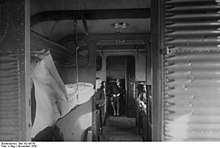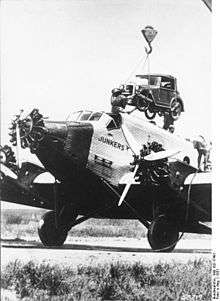Junkers G 31
The Junkers G 31 was an advanced tri-motor airliner produced in small numbers in Germany in the 1920s. Like other Junkers types, it was an all-metal, low-wing cantilever monoplane. Compared to modern aircraft, only the corrugated duralumin metal skin, so typical for Junkers aircraft, seems unusual. However, in the mid-1920s all-metal construction and an aerodynamically 'clean' configuration were remarkable.
| G 31 | |
|---|---|
.jpg) | |
| Junkers G31 | |
| Role | Airliner |
| National origin | Germany |
| Manufacturer | Junkers |
| First flight | 1926 |
| Primary user | Deutsche Luft Hansa |
| Number built | 13 |
Development
Professor Junkers wanted to follow up on the commercial success of the tri-motor G 24 with a new design that would be larger, more comfortable for passengers, and simpler to operate and maintain.[1]
The G 31 was the first Luft Hansa airliner to feature a flight attendant (Wagner p. 264[1]), who served food and drinks (which were not complimentary). This earned the G 31 the nickname 'flying dining car' ('fliegender Speisewagen' in German). Because of its large fuselage it was also called the flying moving van ('fliegender Möbelwagen' in German). Behind the cockpit were compartments for a radio operator, baggage and an APU that provided compressed air for main engine starting and drove a generator for electric power.[2] The cabin was divided into three compartments that held eleven regular passenger seats, four jumpseats for passengers, a jumpseat for the steward, and an enclosed lavatory. Instead of the passenger seats, ten beds could be made up for night flying. There was a baggage and freight hold under the cabin. The wings had trailing edge flaps that reduced the landing speed by ten percent (Wagner p. 267[1]).
Professor Junkers originally requested the G 31 have landing gear that would retract into the wings. After extensive wind tunnel experiments Ernst Zindel, the leader of the design team, persuaded Professor Junkers that the gain in speed provided by reduced air resistance, would not outweigh the increased weight, cost and complexity of either retractable landing gear or simple wheel fairings. The tailskid incorporated a roller, to avoid damage to grass airfields(Wagner p. 262–263[1]).
The intended powerplant was three Junkers L5 engines. When these proved too weak, it was suggested to use the Napier Lion, considered to be the best aero engine at the time ("the best engine for the best plane"). This however was too expensive, especially since it would have had to be paid for in convertible currency, not German Reichsmark. Most G 31s flew with foreign air-cooled radial engines in the 500 hp range, which were licence-built in Germany (see list of variants below)(Wagner p. 265–267[1]).
Operational history
Originally, the G 31 had been intended to equip Junkers' own airline, Junkers Luftverkehr, but this venture was merged into Deutsche Luft Hansa in 1926, and the new airline purchased only eight G 31s, beginning operations in May 1928. They were used on the long-range routes of Luft Hansa, particularly to Scandinavia. They continued in this role until 1935, when replaced by the Junkers Ju 52.
Four other G 31s were sold for freighting cargo in New Guinea. Operated by Guinea Airways, one was owned by the airline itself, while the other three were owned by the Bulolo Gold Dredging Company. Powered by Pratt & Whitney Hornets, these differed from the G 31 airliners in having open cockpits, and a large hatch in the fuselage roof to accommodate the loading of bulky cargo via crane.[3] In one particular operation, the G 31s were used to airlift eight 3,000 tonne (3,310 ton) dredges (in parts) from Lae to Bulolo. Three of the aircraft were destroyed in a Japanese air raid on Bulolo on 21 January 1942, and the remaining aircraft was pressed into RAAF service ten days later. This machine (construction number 3010, registration VH-UOW) was seriously damaged in an accident at Laverton, Victoria on 31 October that year after it careened off the runway and collided with and destroyed the Minister for Air's car.[4][5] Although judged beyond repair by the Air Force, it eventually returned to freighter use in New Guinea for some time after the war.
Unlike the earlier Junkers G 24, the G 31 was not a commercial success, only 13 being sold, as opposed to 54 civilian G 24s (+30 military derivatives)(Wagner p. 267[1]). Compared to the G 24 it offered passengers more comfort. Compared to the more usual biplane airliners of the 1920s, the G 31 was faster, and its all-metal construction made it safer. However purchase price and operating costs were high. Instead of the newly designed G 31, a developed version of the G 24 might have sold better.
Accidents and incidents
- September 25, 1928
- Deutsche Luft Hansa G 31de (c/n J3004; registration D-1427; named Deutschland) crash landed and burned due to an engine fire.[6]
- December 11, 1928
- Deutsche Luft Hansa G 31fi, registration D-1473 and named Rhineland, crashed at Letzlingen due to weather, killing three of four on board.
- May 1936
- G 31 Fo D-ABIL, c/n 3008, collided with Junkers Ju 53/3m D_APUT.[7][8]
Variants

- G 31.1 – prototype with three Junkers L5 engines
- G 31.2 – as G 31.1 with centre engine replaced with BMW VI
- G 31ba – production version of G 31.2
- G 31de – version with three Gnome et Rhone-built Bristol Jupiter VI engines, enclosed cockpit and second tailfin
- G 31fi – version with three Siemens-built Bristol Jupiter engines, and enlarged wing and fuselage
- G 31fo – version with three BMW-built Pratt & Whitney Hornet engines
- G 31ho – as G 31fo with centre engine replaced with Pratt & Whitney Hornet
- G 31go – freighter version for New Guinea with open cockpit and 3.60 m × 1.50 m (11 ft 10 in × 5 ft) cargo hatch in roof.
Operators

Specifications (G 31fo)

Data from Wagner p. 269[1]
General characteristics
- Crew: two pilots, one radio operator and one steward
- Capacity: 15 day passengers or ten night passengers
- Length: 16.50 m (54 ft 1 in)
- Wingspan: 30.50 m (100 ft 0 in)
- Height: 6.00 m (19 ft 8 in)
- Wing area: 102.0 m2 (1,097 sq ft)
- Empty weight: 5,250 kg (11,590 lb)
- Gross weight: 8,500 kg (18,760 lb)
- Powerplant: 3 × BMW-built Pratt & Whitney Hornet , 386 kW (525 hp) each
Performance
- Maximum speed: 210 km/h (131 mph, 114 kn)
- Cruise speed: 170 km/h (106 mph, 92 kn)
- Range: 850 km (528 mi, 459 nmi)
- Endurance: 5 hours 0 minutes
- Service ceiling: 4,400 m (14,400 ft)
- Rate of climb: 3.0 m/s (10 ft/min)
See also
Aircraft of comparable role, configuration and era
Related lists
References
- Wolfgang Wagner "Hugo Junkers Pionier der Luftfahrt – Seine Flugzeuge" Bernard & Graefe Verlag, Bonn 1996 ISBN 3-7637-6112-8 (in German)
- Karl-Dieter Seifert"Der Deutsche Luftverkehr 1926 – 1945 auf dem Weg zum Weltverkehr" Bernard & Graefe Verlag, Bonn 1999 ISBN 3-7637-6118-7 (in German)
- Grant 1998, pp. 49–51.
- "Junkers G31go VH-UOW – Guinea Airways". The Airways Museum & Civil Aviation Historical Society. Retrieved 17 October 2010.
- "RAAF A44 Junkers G31 & W34". ADF Aircraft Serial Numbers. 20 May 2009. Retrieved 17 October 2010.
- "Accident Description". Aviation Safety Network. Flight Safety Foundation. Retrieved 4 January 2018.
- Ranter, Harro. "ASN Aircraft accident Junkers G.31fo D-ABIL". aviation-safety.net. Retrieved 10 February 2020.
- "Civil Aircraft Register - Germany : D-1722". www.airhistory.org.uk. Retrieved 10 February 2020.
- Grant, James Ritchie (1998). "Corrugated Masterpieces:Junkers Types in Australia and Papua New Guinea". Air Enthusiast. No. 77, September/October 1998. Stamford, UK: Key Publishing. pp. 45–77. ISSN 0143-5450.
- "New Junkers Commercial Monoplane". Flight. 17 March 1927. p. 159. Retrieved 2008-07-30.
- Taylor, Michael J. H. (1989). Jane's Encyclopedia of Aviation. London: Studio Editions. p. 537.
External links
| Wikimedia Commons has media related to Junkers G.31. |